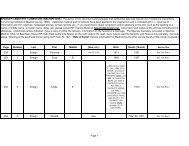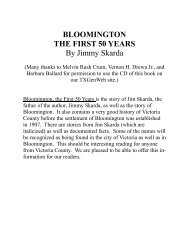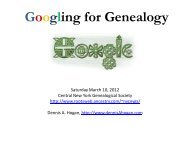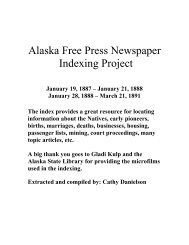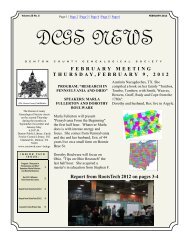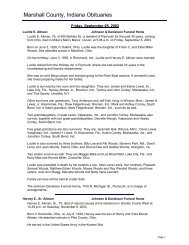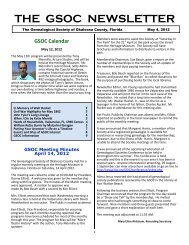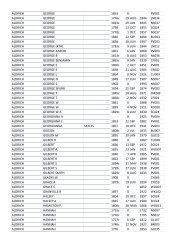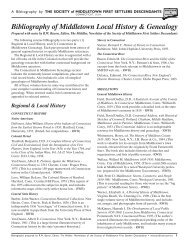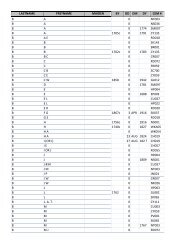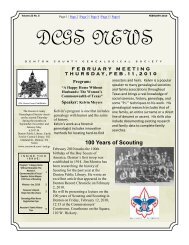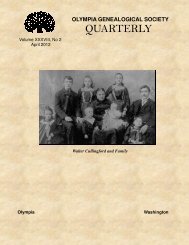Getting to the Roots of Your Family - RootsWeb - Ancestry.com
Getting to the Roots of Your Family - RootsWeb - Ancestry.com
Getting to the Roots of Your Family - RootsWeb - Ancestry.com
You also want an ePaper? Increase the reach of your titles
YUMPU automatically turns print PDFs into web optimized ePapers that Google loves.
e. On <strong>the</strong> given name search, putting only a “J” will act like a “J*” and all names beginning with <strong>the</strong> letter<br />
“J” will be returned.<br />
Pay attention <strong>to</strong> <strong>the</strong> different searches and variables you are using so that you understand what you have<br />
searched and what you haven’t searched. If you’re not careful with your wildcards, you might get many<br />
more search results than you want.<br />
4. It was <strong>com</strong>mon for a widow <strong>to</strong> revert <strong>to</strong> her maiden name. If you are looking for a possible second<br />
marriage, remember that <strong>the</strong> maiden name was likely used.<br />
5. If you are unable <strong>to</strong> find a child in civil registration that you believe existed from <strong>the</strong> census, try using <strong>the</strong><br />
mo<strong>the</strong>r’s maiden name. The child may be illegitimate.<br />
6. Research everyone in a family in each generation. As parents get older, <strong>the</strong>y will <strong>of</strong>ten live with one <strong>of</strong><br />
<strong>the</strong>ir children. This can tie one generation <strong>to</strong> <strong>the</strong> next.<br />
7. Always look at <strong>the</strong> original record. You never know what clues will be found in <strong>the</strong> original that aren’t in<br />
<strong>the</strong> index. You may miss something extremely valuable as well as get a sense <strong>of</strong> record such as how<br />
<strong>com</strong>plete it is and how legible it would have been <strong>to</strong> an indexer.<br />
8. The Scottish were <strong>of</strong>ten big on <strong>the</strong> following naming pattern:<br />
a. First son named after <strong>the</strong> fa<strong>the</strong>r’s fa<strong>the</strong>r<br />
b. Second son named after <strong>the</strong> mo<strong>the</strong>r’s fa<strong>the</strong>r<br />
c. Third son after <strong>the</strong> fa<strong>the</strong>r<br />
d. First daughter after <strong>the</strong> mo<strong>the</strong>r’s mo<strong>the</strong>r<br />
e. Second daughter after <strong>the</strong> fa<strong>the</strong>r’s mo<strong>the</strong>r<br />
f. Third daughter after <strong>the</strong> mo<strong>the</strong>r<br />
Some families followed <strong>the</strong> pattern religiously, o<strong>the</strong>rs not at all. Paying attention <strong>to</strong> this however may help<br />
determine which ances<strong>to</strong>r is yours when <strong>the</strong>re is more than one possibility. It can get a little tricky when,<br />
say, both fa<strong>the</strong>rs share <strong>the</strong> same given name.<br />
9. Always evaluate your information. Consider <strong>the</strong> following:<br />
o Did <strong>the</strong> person providing <strong>the</strong> information witness <strong>the</strong> event?<br />
o Was <strong>the</strong> information recorded at or near <strong>the</strong> time <strong>of</strong> <strong>the</strong> event?<br />
o Is <strong>the</strong> information consistent and logical?<br />
o Does it suggest a place <strong>to</strong> go next?<br />
For example, we were all at our births but we are not <strong>the</strong> primary source <strong>of</strong> information for when and<br />
where we were born. Someone had <strong>to</strong> tell us because we couldn’t have cared less at <strong>the</strong> time☺. It is<br />
similar at <strong>the</strong> time <strong>of</strong> our deaths, <strong>the</strong> birth information is usually provided by someone who wasn’t <strong>the</strong>re.<br />
10. Don’t forget <strong>to</strong> return <strong>to</strong> indexes such as <strong>the</strong> Scottish Church Records index available at your <strong>Family</strong> His<strong>to</strong>ry<br />
Center or <strong>the</strong> International Genealogical Index (IGI) when moving <strong>to</strong> a new generation.<br />
11. Make sure and learn something about <strong>the</strong> place you are researching. Knowing more about where an<br />
ances<strong>to</strong>r lived will help you understand <strong>the</strong>m better and may help you determine family relationships<br />
when <strong>the</strong>re are potential conflicts. For Scotland, consider <strong>the</strong> following:<br />
o A Topographical Dictionary <strong>of</strong> Scotland, Samuel Lewis, 1851, British Reference 941 E5L 1989<br />
o The Gazetteer <strong>of</strong> Scotland, John Wilson, 1882, British Reference 941 E5j<br />
o Ordnance Gazetteer <strong>of</strong> Scotland, Francis H. Groome, ca. 1894, British Reference 941 E5g 1894



